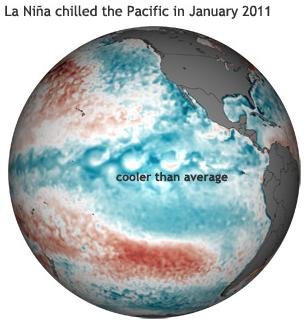The lead character of the 2011 climate story was a double dip La Nina, which chilled the Pacific at the start and end of the year. Many of the 2011 seasonal climate patterns around the world were consistent with common side effects of La Nina. Credit: NOAA
WASHINGTON, July 16 (UPI) -- Extreme global weather in 2011 was caused by back-to-back La Nina phenomena that cooled the planet, U.S. weather experts say.
The finding was included in the 2011 State of the Climate report issued online by the National Oceanographic and Atmospheric Administration.
"2011 will be remembered as a year of extreme events, both in the United States and around the world," Deputy NOAA Administrator Kathryn D. Sullivan, said. "Every weather event that happens now takes place in the context of a changing global environment."
The back-to-back La Ninas, featuring cooler-than-average water temperatures in the eastern equatorial Pacific Ocean, affected regional climates and influenced many of the world's significant weather events throughout the year, including historic droughts in East Africa, the southern United States and northern Mexico, the NOAA report said.
The conditions also contributed to an above-average tropical cyclone season in the North Atlantic hurricane basin and a below-average season in the Eastern North Pacific, and brought the wettest two-year period (2010–2011) on record in Australia, scientists said.
The report details extreme events experienced all over the globe, including the worst flooding in Thailand in almost 70 years, drought and deadly tornado outbreaks in the United States, devastating flooding in Brazil and the worst summer heat wave in central and southern Europe since 2003.
The report used 43 climate indicators, including greenhouse gas concentrations, temperature of the lower and upper atmosphere, cloud cover, sea surface temperature, sea level rise, ocean salinity, sea ice extent and snow cover.















